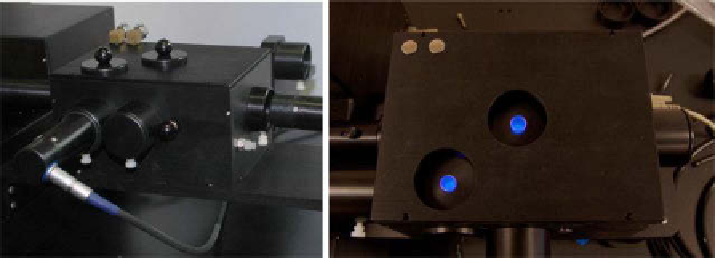Biomedical Engineering Reference
In-Depth Information
6.7 optical techNiques
6.7.1 instrumentation requirements for Nanoparticle characterization
Recording optical spectra of clear solutions in the visible range is a routine operation,
and many types of spectrophotometers are available for this task. Due to the transpar-
ency of biological tissue to NIR photons, optical nanoparticles are designed to absorb
and emit in this spectral range (750-900 nm). Two major impediments to charac-
terize optical nanoparticles include (i) scattering from the nanoparticles that disrupt
the measuring beam in conventional spectrophotometers and (ii) low sensitivity of
commonly used silicon (Si) detectors at wavelengths above 800 nm. In the last two
decades, several instrumentation solutions to these two problems have been proposed
and realized commercially.
6.7.1.1 Absorption Spectrophotometers
Separating scattering from absorption
measurements is one of the major challenges in nanoparticle characterization [35].
Chromophore-specific features of a spectrum are often buried in the high absor-
bance background originating from the scattering component, such as shown in
the spectrum of indocyanine green (ICg) in milk (see fig. 6.18). a classic (but
still in use) strategy developed by B. Chance in 1951 is a dual-wavelength approach
where two detectors are set up at 90° to each other [36]. one detector is coaligned
with the excitation light to provide “chromophore + scatter” data, and the other
provides “scatter” data (fig. 6.17). Subtracting the latter from the former yields
the “chromophore” spectrum only. However, this method has some restrictions:
(i) absorbance changes should be less than 0.01, (ii) the reference wavelength should
be chosen so as to minimize interference from other absorbing components, and
(iii) the wavelengths should be closely spaced [37]. overall, the dual-wavelength
approach does not eliminate scattering completely.
figure 6.17
an integrating cavity absorption meter consists of a two-layer cavity with
walls made from a highly reflective material. With this accessory, the absorption is decoupled
from scattering, allowing accurate measurements of molar absorptivity. (The photos of Clarity
are kindly provided by olis, Inc.)

Search WWH ::

Custom Search